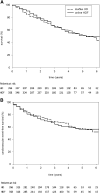Effect of online hemodiafiltration on all-cause mortality and cardiovascular outcomes
- PMID: 22539829
- PMCID: PMC3358764
- DOI: 10.1681/ASN.2011121140
Effect of online hemodiafiltration on all-cause mortality and cardiovascular outcomes
Abstract
In patients with ESRD, the effects of online hemodiafiltration on all-cause mortality and cardiovascular events are unclear. In this prospective study, we randomly assigned 714 chronic hemodialysis patients to online postdilution hemodiafiltration (n=358) or to continue low-flux hemodialysis (n=356). The primary outcome measure was all-cause mortality. The main secondary endpoint was a composite of major cardiovascular events, including death from cardiovascular causes, nonfatal myocardial infarction, nonfatal stroke, therapeutic coronary intervention, therapeutic carotid intervention, vascular intervention, or amputation. After a mean 3.0 years of follow-up (range, 0.4-6.6 years), we did not detect a significant difference between treatment groups with regard to all-cause mortality (121 versus 127 deaths per 1000 person-years in the online hemodiafiltration and low-flux hemodialysis groups, respectively; hazard ratio, 0.95; 95% confidence interval, 0.75-1.20). The incidences of cardiovascular events were 127 and 116 per 1000 person-years, respectively (hazard ratio, 1.07; 95% confidence interval, 0.83-1.39). Receiving high-volume hemodiafiltration during the trial associated with lower all-cause mortality, a finding that persisted after adjusting for potential confounders and dialysis facility. In conclusion, this trial did not detect a beneficial effect of hemodiafiltration on all-cause mortality and cardiovascular events compared with low-flux hemodialysis. On-treatment analysis suggests the possibility of a survival benefit among patients who receive high-volume hemodiafiltration, although this subgroup finding requires confirmation.
Figures



Comment in
-
On-line hemodiafiltration: not a self-fulfilling prophecy.J Am Soc Nephrol. 2012 Jun;23(6):974-5. doi: 10.1681/ASN.2012040424. Epub 2012 May 17. J Am Soc Nephrol. 2012. PMID: 22595303 No abstract available.
References
-
- Eknoyan G, Beck GJ, Cheung AK, Daugirdas JT, Greene T, Kusek JW, Allon M, Bailey J, Delmez JA, Depner TA, Dwyer JT, Levey AS, Levin NW, Milford E, Ornt DB, Rocco MV, Schulman G, Schwab SJ, Teehan BP, Toto R, Hemodialysis (HEMO) Study Group : Effect of dialysis dose and membrane flux in maintenance hemodialysis. N Engl J Med 347: 2010–2019, 2002 - PubMed
-
- Locatelli F, Martin-Malo A, Hannedouche T, Loureiro A, Papadimitriou M, Wizemann V, Jacobson SH, Czekalski S, Ronco C, Vanholder R, Membrane Permeability Outcome (MPO) Study Group : Effect of membrane permeability on survival of hemodialysis patients. J Am Soc Nephrol 20: 645–654, 2009 - PMC - PubMed
-
- Lin CL, Yang CW, Chiang CC, Chang CT, Huang CC: Long-term on-line hemodiafiltration reduces predialysis beta-2-microglobulin levels in chronic hemodialysis patients. Blood Purif 19: 301–307, 2001 - PubMed
-
- Lornoy W, Becaus I, Billiouw JM, Sierens L, Van Malderen P, D’Haenens P: On-line haemodiafiltration. Remarkable removal of beta2-microglobulin. Long-term clinical observations. Nephrol Dial Transplant 15[Suppl 1]: 49–54, 2000 - PubMed
Publication types
MeSH terms
LinkOut - more resources
Full Text Sources
Other Literature Sources
Medical

